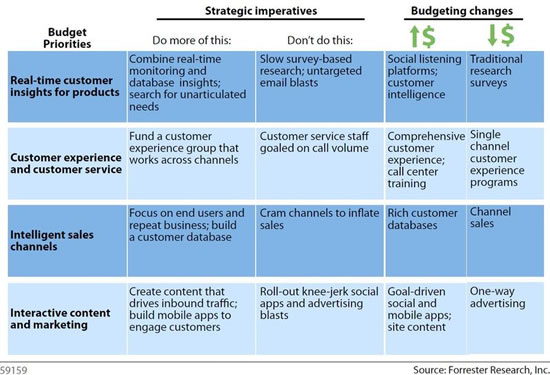Customers are more “empowered”. How to turn customer empowerment into action.
Consumers dispose of more ways to inform themselves, interact and buy when, where and how they want. You don’t really need studies to notice today’s customer is empowered. People still ask for advice but they know better what they want than ever before because digital channels, social connections and content allow them to inform themselves (and buy). Customer empowerment is a given and increasingly will be. Time to turn it into action.
The changing buying behavior and multi-channel information gathering processes consumers display are impacting business and it’s not just about Generation Y or Generation C for that matter. The fact that consumers are more empowered is one of the reasons why businesses adopt a cross-channel touchpoint approach and use social media, content marketing and Big Data, for instance, in an integrated marketing and customer-centric ‘experience’ way.

Customer – and consumer – empowerment is directly related to the end of marketing as we have practiced it. These – and many more – evolutions in how consumers buy and behave also apply in B2B as in the end we’re all consumers and what we do as ‘consumers’ (a term we invented, it’s just people really) has an impact on what we do if we’re in B2B (again a term we invented) mode.
Despite channel fragmentation and changing consumer behavior, we have more ways than ever to offer relevant customer experiences across all touchpoints. The power of the customer isn’t new, it’s just stronger (and Josh Bernoff explained it rather well in 2011 in “Welcome to the Age of the Customer“, with ‘customer obsession’ still being one of Forrester’s key focus topics). Building marketing strategies and integrating around the customer is a matter of understanding customer needs/preferences and acting upon these insights.
Customer empowerment and customer needs: drop the lattes and get out
Gerry McGovern once wrote about how “the trend towards greater and greater customer empowerment requires a deeper and deeper understanding of customer needs”. In his blog post, Gerry quoted a book by Tomer Sharon, Search UX Researcher at Google and author of ‘It’s Our Research’. Quote: “When people, teams, and organizations develop new products and services, they tend to have endless discussions about what users or customers need, who customers are, and what features the design of their offering should have.” It’s what Gerry calls “designing with five smart people in a room drinking lattes syndrome”.
Indeed, “there are no facts inside the building” as Steve Blank said and “we need to get out of the building”. In a digital and social business world, characterized by connectivity and speed, getting out means getting out on the Web more often too and looking at the overall digital customer experience.
Focusing on the customer needs is not about gut feeling or intuition, general best practices, bringing smart people around the table and taking decisions about what we and especially the HIPPOs (Highest Paid Person’s Opinion) in the room decide anymore.
So, what is it about? It’s about getting the right customer data, input, feedback and insights, and turning them into action. Or in other words: customer involvement, direct or indirect. It’s about the Voice of the Customer (VoC).
Five ways to turn customer empowerment into action
- Asking what your customers want might not always be the best idea (there’s a gap between what people say and do) but it is certainly a must when it boils down to information, communication, service, customer experiences, rationalized needs, etc. Customers can also be involved directly via various VoC initiatives including techniques such as…calling them and of course by inviting them to usability experiments.
- We often make the mistake to think we know what our customers want if we put ourselves in their shoes. And while empathy will certainly help in everything we do, it’s not the best option: you are not your customer. Nevertheless, turn to the people who are most involved with your customers on a daily basis and know them personally. You know what divisions I’m talking about.
- Behavior-based data and insights are key . In usability they are gathered by conducting all sorts of tests. In the ways we interact with our customers, the same goes be it in somewhat different ways: analyzing customer behavior across channels to get a holistic view, data on campaigns, etc. Obviously these data need to be turned into insights and actions.
- We shouldn’t forget the role of (A/B and MVT) testing either. Testing features enable us to set up tests and (automatically) pick the best message or landing page but in the end testing is really about what the customer prefers.
- Finally, don’t underestimate the importance of using online surveys, NPS and customer feedback within a customer service scenario. People do know which movie they liked or not and how they felt about a specific holiday destination. Integrate! However, don’t forget the quid pro quo, make sure you don’t overdo it and value input by acting upon the customer feedback!
The days of intuition are over. Those of gaining an integrated customer view, backed by solid data, and continuous optimization have come. ‘Get out there’. In real-life and online. Certainly now real-life increasingly shifts to digital life in the ways we search, prepare, buy and interact. It has an impact on everything, including the way how we budget our digital marketing plans as you can read in “Stop and Rework your Digital Marketing Budget Right Now“.


